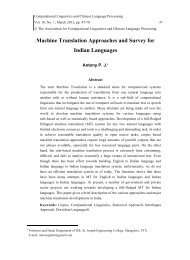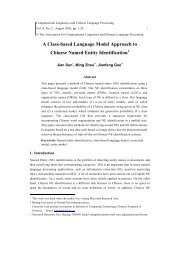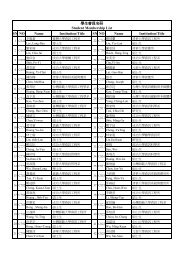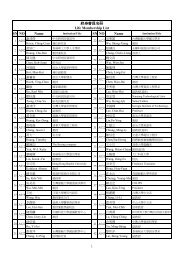Automatic Recognition of Cantonese-English Code ... - Aclclp.org.tw
Automatic Recognition of Cantonese-English Code ... - Aclclp.org.tw
Automatic Recognition of Cantonese-English Code ... - Aclclp.org.tw
Create successful ePaper yourself
Turn your PDF publications into a flip-book with our unique Google optimized e-Paper software.
286 Joyce Y. C. Chan et al.<br />
in a standard dictionary. In the example <strong>of</strong> Table 3, the initial consonant /n/ <strong>of</strong> the first<br />
syllable is commonly pronounced as /l/ by the younger generation. Syllable fusion is <strong>of</strong>ten<br />
seen in fast speech, i.e., the initial consonant <strong>of</strong> the second syllable <strong>of</strong> a disyllabic word tends<br />
to be omitted or changed (Kam, 2003; Wong, 2004).<br />
Table 3. An example <strong>of</strong> a <strong>Cantonese</strong>-<strong>English</strong> code-mixing sentence<br />
<strong>Code</strong>-mixing speech<br />
你 哋 plan 咗 行 程 未 ?<br />
You (plural) plan already schedule or not<br />
Transcription according to standard pronunciation dictionary<br />
/nei/ /tei/ /p l Q n/ /ts ç/ /h åN/ /ts I N/ /m ei/<br />
Transcription according to typical pronunciation in code-mixing speech<br />
/lei/ /tei/ /p Q n/ /ts ç/ /h åN/ /ts I N/ /m ei/<br />
<strong>English</strong> translation<br />
Have you planned your schedule already?<br />
2.3 Problems and Difficulties in <strong>Code</strong>-mixing Speech <strong>Recognition</strong><br />
Large-vocabulary continuous speech recognition (LVCSR) systems deal with fluently spoken<br />
speech with a vocabulary <strong>of</strong> thousands <strong>of</strong> words or more (Gauvain & Lamel, 2000). As shown<br />
in Figure 1, the key components <strong>of</strong> a state-<strong>of</strong>-the-art LVCSR system are acoustic models,<br />
pronunciation dictionary, and language models (Huang et al., 2001). The acoustic models are<br />
a set <strong>of</strong> hidden Markov models (HMMs) that characterize the statistical variation <strong>of</strong> the input<br />
speech features. Each HMM represents a specific sub-word unit such as a phoneme. The<br />
pronunciation dictionary and language models are used to define and constrain the ways in<br />
which the sub-word units can be concatenated to form words and sentences.<br />
Figure 1. The flow diagram <strong>of</strong> an LVCSR system









